Stay Informed
Popular Articles
- Hiatal Hernia: Hidden Cause of Chronic Illness
- Small Intestinal Bacterial Overgrowth (SIBO)
- Applied Lymphology: Unlocking the Secret to Pain Relief
- An Introduction to Constitutional Iridology
- The Low Down on Liver Detoxification
- An Energetic and Emotional Approach to Cancer
- Fat Facts
- Marrow in the Bones
- Blood Type and Nutrition
- Cardiac Herbs: Beyond Hawthorn
Quick Search
The School of Modern Herbal Medicine




Can a 53-Year-Old Man Teach Women Anything About Skin Care?
- 5/2/2008
- Categorized in: Specific Health Problems
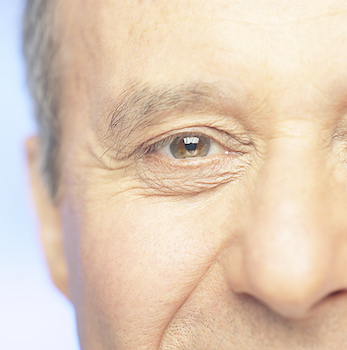 I'm a male, and like many males I don't put a lot of time, money or effort into skin care. Let's face the obvious facts: Women are more motivated than men to spend money on lotions, cleansers, toners, cosmetics and other beauty-care products and invest the time necessary to use them. Most guys don't really care that much about the subject.
I'm a male, and like many males I don't put a lot of time, money or effort into skin care. Let's face the obvious facts: Women are more motivated than men to spend money on lotions, cleansers, toners, cosmetics and other beauty-care products and invest the time necessary to use them. Most guys don't really care that much about the subject.
So, as I prepared to write this article on natural skin care, the question naturally arose in my mind, “What qualifies me to write about this topic?” As I pondered this question, I remembered that I've had numerous compliments on my skin from women. This includes a number of massage therapists who have worked on me, and while it didn't mean much to me at the time (see footnote), it did cause me to consider why I have such good skin at my age.
Frankly, I look around at other people my age, both men and women, and I'm surprised at how old they look. It made me take a serious look in the mirror and ask, “Do I look that old?” Thankfully, the answer is "No." In fact, people regularly under-guess my age by 5-15 years. (By the way, this is still true neary 10 years after I wrote the original article. I still get compliments on my skin and people still guess that I'm much younger than I am.)
So, that got me thinking about aging and wondering, “Why do I have skin that's much healthier than most people my age?” The natural question that follows is, “And, what is my secret or secrets?” That's what I plan to address in this article. (Please understand that I may be totally wrong. After all, my healthy skin could be just the luck of my genetics, but I don't really believe that.) So here goes.
Secret #1: Only Use Natural Soaps
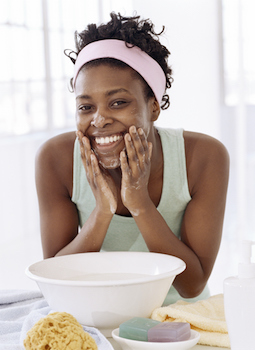 I don't use commercial bar soaps for bathing or showering. In fact, I haven't purchased a grocery store brand of bar soap in over thirty years. It started when naturopath Jack Ritchason told me about the acid mantle that protects the skin. The acid mantle is a thin coating on the surface of the skin created by secretions from the sweat glands and oil glands. This coating has a slightly acidic pH and forms a natural barrier against infections. It also protects the skin from environmental irritants and keeps the skin moist.
I don't use commercial bar soaps for bathing or showering. In fact, I haven't purchased a grocery store brand of bar soap in over thirty years. It started when naturopath Jack Ritchason told me about the acid mantle that protects the skin. The acid mantle is a thin coating on the surface of the skin created by secretions from the sweat glands and oil glands. This coating has a slightly acidic pH and forms a natural barrier against infections. It also protects the skin from environmental irritants and keeps the skin moist.
Jack Ritchason also taught me that bar soaps, which are highly alkaline, dissolve away the acid mantle and change the pH of the skin to an alkaline state. This actually makes the skin more prone to infections. In fact, these harsh antibacterial soaps everyone is now using are especially bad for the skin. There is an obsession with the idea that if we kill all germs, we aren't going to get sick, and that's hogwash.
Like the intestines, the skin is home to friendly micro-organisms. And, like our intestines, the skin is a natural ecosystem, playing host to numerous friendly microbes. You're never going to be able to kill all the microbes on the skin, and you don't want to. Killing the friendly microbes just makes the skin more susceptible to colonization by unfriendly microbes.
As a result of what I learned 30 years ago, I started using Dr. Bronner's Castile soap for bathing, because I was told it didn't destroy the acid mantle of the skin. I consider all such information as interesting ideas until I've actually tested them, but in this case, the test had a very positive result. After I'd used the Castile soap for a while, I did notice a difference in the way my skin felt, so I've continued to use it ever since.
I have started using some natural bar soaps that have a high glycerin content in recent years. These are the kind of soaps that come in big blocks where you cut a piece off. The Lush Cosmetics sells some great soaps like this. My favorite is one called Karma. You can order it (and other Lush products) online or find a store near you.
The only exception to this is when I'm traveling. I used to take some with me in a small bottle, but after it leaked in my suitcase a few times, I gave up and just use the little bar soaps at the hotels for a few days. I really don't like it when I have to do this, and it reinforces for me that there is a big difference between a pure soap and the commercial bar soaps, body shampoos, etc.
The bottom line is that I think using this natural soap is the main reason why my skin is as healthy as it is. So, my first recommendation to all of you lady's (and guys) who want healthy skin is to throw away the harsh alkaline soaps and start using a natural cleaner that doesn't destroy the acid mantle of the skin. And, don't use antibacterial soaps. You have friendly flora on your skin as well as in your gut.
Secret #2: Avoid Putting Chemicals on Your Skin
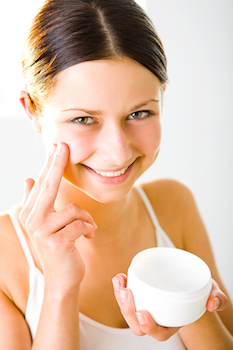 I liked what Kat James had to say about most cosmetics and personal care products when she spoke at the Nature's Sunshine Leader's Conference in 2005. Kat wrote a very good book called The Truth About Beauty. She said that a lot of this “stuff” that people are putting on their skin and in their hair is actually harming their health and damaging their body in the process. So, in the long run, it doesn't make you look good.
I liked what Kat James had to say about most cosmetics and personal care products when she spoke at the Nature's Sunshine Leader's Conference in 2005. Kat wrote a very good book called The Truth About Beauty. She said that a lot of this “stuff” that people are putting on their skin and in their hair is actually harming their health and damaging their body in the process. So, in the long run, it doesn't make you look good.
Of course, being a guy, I never wear make-up. Okay, that's not quite true. The lady at the studio gives a dusting of facial powder so my high forehead doesn't “shine” under the bright lights when recording video. And, I've also worn make-up when I was in a play. But other than that, I never wear make-up. On those few occasions where I have to have that stuff on my face I feel sorry for the ladies. I pay a lot of attention to the feedback my body gives me about things, and it just doesn't feel “right” to have that stuff on my skin.
I feel the same way about lotions and hair care products. I'll put a little natural lotion on my hands after they've been dried out from working in the clay soil of my garden (the clay pulls the oil out of the skin), but that's about it for the lotions.
Likewise, I've tried putting some of those gel products in my hair, and I hated it. I didn't like the feel of the stuff on my scalp. It just felt “wrong.” Then, because I needed something for when I had to look professional (I have very thin, fine hair), I read the labels of every product at the health food store until I found an all natural gel product that didn't contain ANY chemical ingredients. I bought it, and it feels fine on my scalp.
The bottom line is, I'm as careful about what I put ON my body as I am about what I put IN my body. Most of those personal care products are just loaded with completely unnatural chemicals. Just read the labels. I avoid that stuff just the way I avoid food additives.
So, healthy skin secret number two is to trash all those chemical-laden personal care products. Find some more natural alternatives, or do without them entirely. If you're taking care of your body properly, there's a natural beauty that comes from healthy skin and hair that all that make-up/personal care stuff will never be able to create.
Secret #3: Eat Your Skins and Bones
 Around the same time I learned about the acid mantle, I read a great article on silica by an Australian naturopath, Dorothy Hall. I'm sure most of you have heard that silica is important for healthy skin, as well as healthy nails, hair, bones, teeth, nerves and glands. The article really opened my eyes to the relationship between minerals and specific qualities of tissue.
Around the same time I learned about the acid mantle, I read a great article on silica by an Australian naturopath, Dorothy Hall. I'm sure most of you have heard that silica is important for healthy skin, as well as healthy nails, hair, bones, teeth, nerves and glands. The article really opened my eyes to the relationship between minerals and specific qualities of tissue.
Silica makes things tough but pliable. So, foods rich in silica are chewy. In plant foods, for instance, silica is found in the shiny coat (i.e., skin) of seeds and in the peelings (skin, again) of fruits and vegetables. Silica is also found in the chewy parts of animal tissue (i.e., bones and connective tissue). Unfortunately, because we're kind of addicted to “soft” food, those are the parts we tend to throw away.
I mean, think about a horse. Does a horse peel and core his apple before he eats it? Of course not, he eats the entire thing. And where does the worm head? For the mineral rich core of the apple. So, in plants like cucumbers, squash, pears, etc. most of the minerals that are needed for healthy skin are found in the skin, the parts we peel off and throw away.
So, I started learning to eat peelings (and cores, too). When I eat my organic apples, there's nothing left but a tiny piece of stem when I'm finished. I eat the peelings of potatoes and lots of other produce, too. I think this not only keeps my fingernails pretty tough, it also helps my skin look great. Of course, you can also take HSN-W (which I have done occasionally), but why not eat your fruit and vegetable skins?
My favorite nutrition book, Nourishing Traditions by Sally Fallon taught me that all traditional cultures made broths, which helped them maintain healthy teeth, bones, hair, nails, and of course, skin. What peelings they didn't eat, they threw in a pot with the bones and tough, chewy parts of the animals they consumed. Then they added some water (and a little vinegar), brought the stuff to a boil, skimmed off the crude and simmered it for 12-24 hours. This process pulled all those nice minerals out of the bones, sinews, peelings, etc. and into solution. The resulting broth is rich in calcium, phosphorus, silica, glucosamine and a bunch of other nutrients for a healthy structural system. (No wonder these people almost never had cavities or arthritis).
So, I've started making broths, too. It's how I've decided to consume some bones as well as some skin to keep my own skin and bones healthy. You might want to consider doing something similar. There's an article about Making Stock (or Bone Broth) on this website.
Secret #4: Know the Skinny on Fats
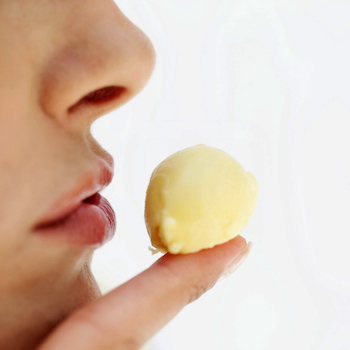 Just about everyone in modern society “knows” that fats are bad, that margarine is healthier than butter, that vegetable oils are better for you than animal fats, and that saturated fats cause heart disease. And, everyone who “knows” all of this is misled.
Just about everyone in modern society “knows” that fats are bad, that margarine is healthier than butter, that vegetable oils are better for you than animal fats, and that saturated fats cause heart disease. And, everyone who “knows” all of this is misled.
First of all, fats aren't bad. Yes, there are fats that aren't healthy for you, and too much of anything isn't good, but the right kind of fats are actually good for you. And, if you want soft, supple skin that feels great to the touch (like a baby's skin), then you want to eat fats.
As for me, I'm a “food snob.” I'll absolutely confess to the fact that I'm addicted to great tasting food. I grew up eating butter and I never liked the taste of margarine, so I shun the stuff. I like my butter and that's what I've spread on my toast my entire life, which is another factor I believe has contributed to my healthy skin. Nowadays, I make “Better Butter” by mixing softened butter with flax seed oil to make soft-spread butter. It's delicious—and good for you!
More recently, I've learned what a good fat coconut oil is and I've started using coconut oil for frying, baking and applications where butter or olive oil just doesn't work. I've also been using coconut milk to make breakfast shakes. I've noticed that the few blemishes I've tended to get on my legs have been clearing up since I started doing this. Chalk another one up for good fats.
Oh, by the way. Your thyroid needs to be working, too, if you want those fats to keep your skin soft. So you may need some iodine and support for your thyroid, especially if you have dry skin. And, one more thing, I don't use bromide or chlorine in my hot tub. Not only does it kick iodine out of your tissues, it's terribly irritating to your skin. I'm keeping my hot tub clean with 500 PPM colloidal silver, hydrogen peroxide and enzymes. It's working great, too!
Secret #5: Cleansing the Skin with Herbs and Clay
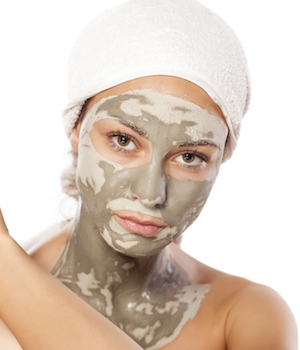 Of course, you want to keep the skin clean, but there's more to keeping the skin clean than just washing it. One has to keep the skin clean from the inside out, as well. Skin problems are typically indications of a toxic colon (intestinal inflammation and “leaky gut,” which is next month's topic, by the way), an overburdened liver and stressed kidneys. Lymphatic drainage and circulation have a lot to do with keeping the skin healthy, too.
Of course, you want to keep the skin clean, but there's more to keeping the skin clean than just washing it. One has to keep the skin clean from the inside out, as well. Skin problems are typically indications of a toxic colon (intestinal inflammation and “leaky gut,” which is next month's topic, by the way), an overburdened liver and stressed kidneys. Lymphatic drainage and circulation have a lot to do with keeping the skin healthy, too.
I've seen many skin problems clear up with combinations traditionally called blood purifiers. These include single herbs like burdock, red clover, dandelion, yellow dock and chapparal. Formulas containing these herbs can be very effective for promoting healthy skin. My favorite blood purifier formulas are from Nature's Sunshine Products: Chinese Liver Balance and All Cell Detox, but there are many others. These combinations typically improve elimination through the colon, liver and kidneys, thus clearing up skin problems. A little fiber and extra water really helps, as well.
However, if you've got itchy, irritated skin and/or want to detox the body faster, a good clay bath is the ticket. Clay is a fantastic cleanser for the skin. I've even read how some native tribes, living in areas where water was scarce, kept their skin clean with clay. They simply rubbed the wet clay all over their body, and then, they waited until it dried and dusted it off.
I realize that this wouldn't be very socially acceptable (or desirable) in modern society, but clay is still wonderful for skin care. When I was in Rotorua, New Zealand many years ago at an NSP New Zealand convention, I learned how the local hospital took the mud from some of the hot pots (a mixture of fine clay and the mineral water) and applied it to joints and other parts of the body for healing and pain relief.
So, how does it work? If you think about what clay does to your skin when it dries on it, you'll get an idea about what it can do for you. Clay dries your skin out. That's because clay absorbs oils from the skin. This oil-pulling action of clay helps the skin detoxify, making clay a wonderful remedy for acne, pox, rashes, oily skin and itching. You see, a lot of skin problems involve rancid fats or fat-soluble irritants that clog up the skin pores and irritate the skin. Clay can pull these toxins out of the skin.
I love a good clay bath now and again. I use Redmond clay. It's a fine clay mined from Redmond, Utah. They also sell an wonderful natural salt I use regularly that is slightly pink. I got hooked on the product back then, and have continued to use it regularly. (You can get a 6lb tub of it.) NSP's Hydrated Bentonite also works well, but it takes a whole bottle to make a good clay bath and that's a pretty expensive bath. You can also use any fine, clean clay.
Clay can be applied overnight to blemishes to help clear them up. It makes a great masque for the face, or a compress for any part of the body. It's helpful for bee stings, insect bites, stinging nettle “stings” and minor skin irritations. It also helps pull heavy metals from the body.
There are many healing uses for clay. If you want to learn more about it, there's a great book called Our Earth, Our Cure by Raymond Dextreit. And you thought dirt was something you had to keep OFF your skin to keep it healthy.
Well, I hope this 53-year-old male has provided the ladies with some useful suggestions for healthier and better-looking skin. And you guys, it's not unmanly to have healthy skin (women like it too), so you might want to apply some of these secrets.
_______________________
Footnote: I know the ladies meant these comments about my skin as a compliment, but ladies, let me make a suggestion— guys prefer to be complimented on their manly qualities. Being told you have soft skin doesn't feel like that much of a compliment to a guy. If you want to make him feel good, tell him he's “strong, brave, clever, handsome, etc.” not that he has "soft skin."
